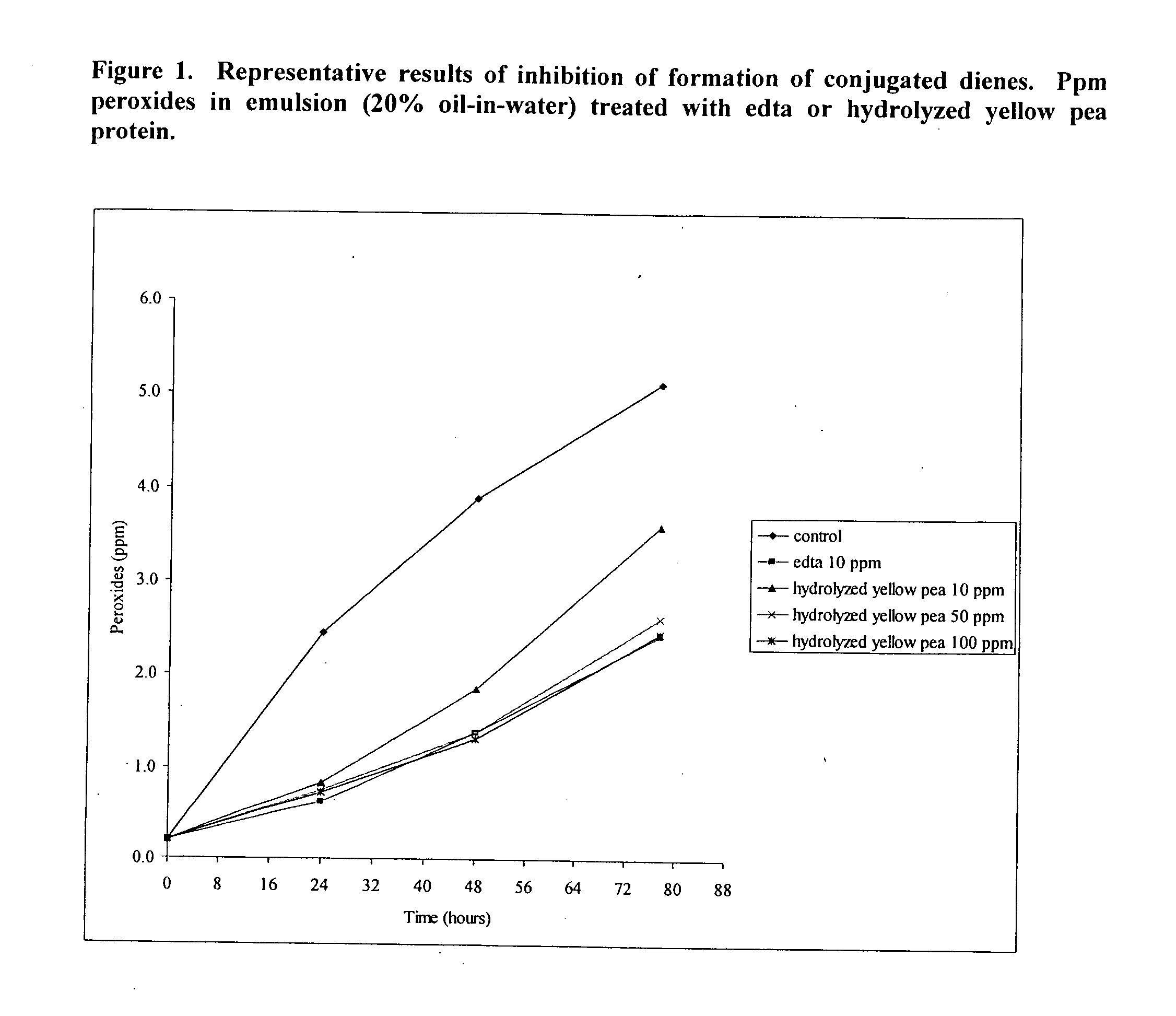Methods for enhancing the stability of foods, beverages, and cosmetics using natural products derived from non-allergenic proteinaceous sources
a technology of non-allergenic proteinaceous and natural products, which is applied in the direction of peptidases, enzymology, peptides, etc., can solve the problems of significant increase in bioavailability, deterioration of food quality and formation of off-flavors, and limiting factors in the utilization of food proteins as sources of therapeutic peptides, so as to stabilize the fresh flavor and slow down the rate of oxidation. , the effect of stabil
- Summary
- Abstract
- Description
- Claims
- Application Information
AI Technical Summary
Benefits of technology
Problems solved by technology
Method used
Image
Examples
example 1
Enzymatic Hydrolysis of Isolated Vegetable Proteins (with ALCALASE® 2.4 L).
[0085]Yellow pea protein isolate was weighed (200 g) into a vessel and ten times the weight of water was added to the vessel. The contents were then stirred and heated to 50° C. The pH was monitored and adjusted to within a range of 8.0 to 8.6 with a solution of 45% potassium hydroxide (KOH). After the temperature and pH were stable, ALCALASE® 2.4 L (Novozymes NS) was added at a 1:100 enzyme:substrate (v / w) ratio. The pH was monitored and adjusted with KOH to keep it within a range of 8.0 to 8.6. The hydrolysis was allowed to proceed until the pH reached a stable value and the mixture no longer needed the addition of KOH. The hydrolysis was stopped by heating the mixture to 80° C. for 5 minutes to denature the enzyme. The mixture was then removed from the heat and allowed to cool to room temperature. The mixture was then centrifuged at approximately 3000×g for 3 hours. The supernatant was decanted and the wat...
example 2
Showing an Example of a Hydrolysis with a Different Enzyme (Trypsin)
[0086]Yellow pea protein isolate was weighed (200 g) into a vessel with sufficient volume to hold all materials. Next, ten times the weight of water was added to the vessel. The contents were then stirred and heated to 50° C. The pH was monitored and adjusted to within a range of 8.0 to 8.6 with a solution of 45% potassium hydroxide (KOH). After the temperature and pH was stable, trypsin was added at a 1:100 enzyme:substrate (v / w) ratio. The pH was monitored and adjusted with KOH to keep it within a range of 8.0 to 8.6. The hydrolysis was allowed to proceed until the pH reached a stable value and the mixture no longer needed the addition of KOH. The hydrolysis was stopped by heating the mixture to 80° C. for 5 minutes to denature the enzyme. The mixture was then removed from the heat and allowed to cool to room temperature. The mixture was then centrifuged at approximately 3000×g for 3 hours. The supernatant was dec...
example 3
Metal Chelation Screening Assay—Ferrozine Assay
[0087]A 10,000 ppm stock solution of the yellow pea hydrolysate was made by weighing 100 mg of the hydrolysate and dissolving it in 10 mL of dH20 or MeOH. Solutions of ferrozine and iron sulfate heptahydrate (FeS04) were made in dH2O at concentrations of 2 mM and 5 mM respectively. Working solutions of the hydrolysates were made in duplicate by diluting the stock in MeOH or H20. A control of MeOH or H20 without hydrolysate was included. Blanks, to measure background absorbance, were diluted to the same concentration in the same manner. First, 167 μL of the FeS04 solution was added to the control and shaken vigorously by hand 20 times. Second, 335 μL of the ferrozine solution was added the samples and shaken vigorously by hand ten times. Each sample was then subsequently treated in the same manner. The blanks had neither of the solutions added. The samples were then allowed to incubate at room temperature for ten minutes. Next, a spectro...
PUM
| Property | Measurement | Unit |
|---|---|---|
| Antioxidant | aaaaa | aaaaa |
Abstract
Description
Claims
Application Information
 Login to View More
Login to View More - R&D
- Intellectual Property
- Life Sciences
- Materials
- Tech Scout
- Unparalleled Data Quality
- Higher Quality Content
- 60% Fewer Hallucinations
Browse by: Latest US Patents, China's latest patents, Technical Efficacy Thesaurus, Application Domain, Technology Topic, Popular Technical Reports.
© 2025 PatSnap. All rights reserved.Legal|Privacy policy|Modern Slavery Act Transparency Statement|Sitemap|About US| Contact US: help@patsnap.com



